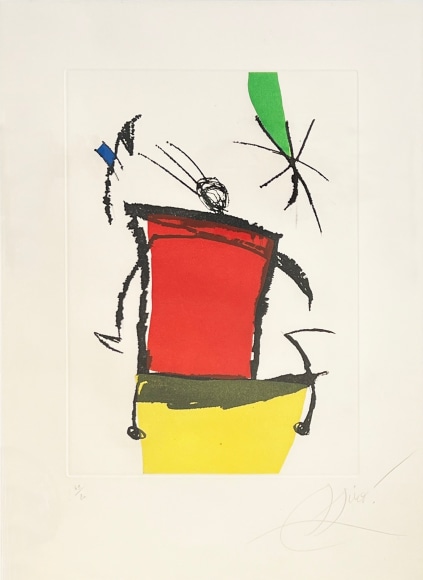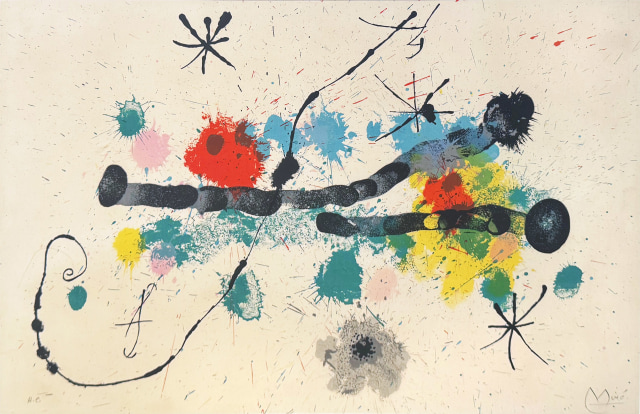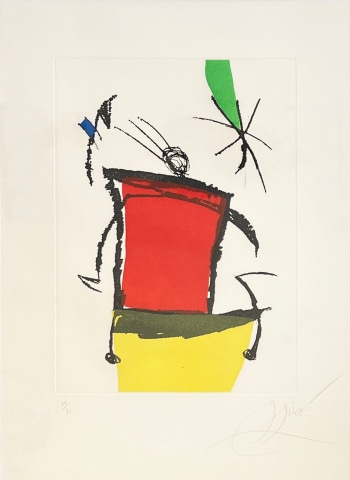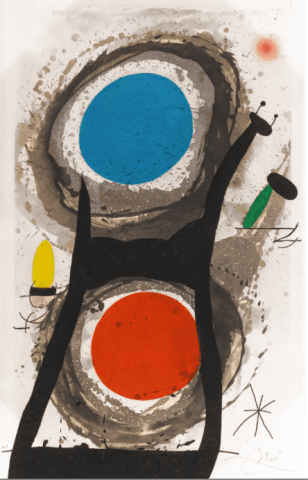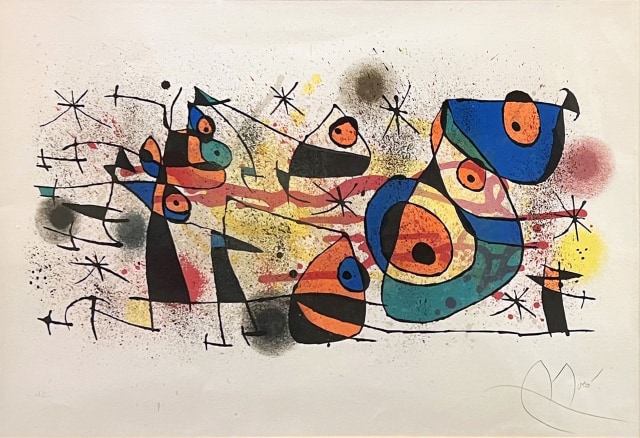
Joan Miró
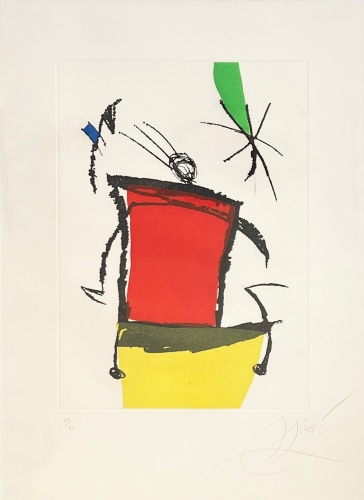
L'Adorateur Du Soleil, 1969
Joan Miró (1893 – 1983)
Joan Miró was a Catalan painter, sculptor, and ceramicist born in Barcelona. A museum dedicated to his work, the Fundació Joan Miró, was established in his birth city in 1975.
Earning international acclaim, his work has been interpreted as Surrealism, a sandbox for the subconscious mind, a re-creation of the childlike, and a manifestation of Catalan pride. In numerous interviews dating from the 1930s onwards, Miró expressed contempt for conventional painting methods as a way of supporting bourgeois society, and famously declared an “assassination of painting” in favour of upsetting the visual elements of established painting.
Born to the families of a goldsmith and a cabinet-maker, he grew up in the Barri Gòtic neighborhood of Barcelona. His father was Miquel Miró Adzerias and his mother was Dolores Ferrà. He began drawing classes at the age of seven at a private school at Carrer del Regomir 13, a medieval mansion. In 1907 he enrolled at the fine art academy at La Llotja, to the dismay of his father. He studied at the Cercle Artístic de Sant Lluc and he had his first solo show in 1918 at the Dalmau Gallery, where his work was ridiculed and defaced. Inspired by Cubist and surrealist exhibitions from abroad, Miró was drawn towards the arts community that was gathering in Montparnasse and in 1920 moved to Paris, but continued to spend his summers in Catalonia.
Miró initially went to business school as well as art school. He began his working career when he was a teenager as a clerk, although he abandoned the business world completely for art after suffering a nervous breakdown. His early art, like that of the similarly influenced Fauves and Cubists exhibited in Barcelona, was inspired by Vincent Van Gogh and Paul Cézanne. The resemblance of Miró’s work to that of the intermediate generation of the avant-garde has led scholars to dub this period his Catalan Fauvist period.
Featured works
Biography
A few years after Miró’s 1918 Barcelona solo exhibition, he settled in Paris where he finished a number of paintings that he had begun on his parents’ farm in Mont-roig del Camp. One such painting, The Farm, showed a transition to a more individual style of painting and certain nationalistic qualities. Ernest Hemingway, who later purchased the piece, compared the artistic accomplishment to James Joyce’s Ulysses and described it by saying, “It has in it all that you feel about Spain when you are there and all that you feel when you are away and cannot go there. No one else has been able to paint these two very opposing things. Miró annually returned to Mont-roig and developed a symbolism and nationalism that would stick with him throughout his career. Catalan Landscape (The Hunter) and the Tilled Field, two of Miró’s first works classified as Surrealist, employ the symbolic language that was to dominate the art of the next decade.
In 1924, Miró joined the Surrealist group. The already symbolic and poetic nature of Miró’s work, as well as the dualities and contradictions inherent to it, fit well within the context of dream-like automatism espoused by the group. Much of Miró’s work lost the cluttered chaotic lack of focus that had defined his work thus far, and he experimented with collage and the process of painting within his work so as to reject the framing that traditional painting provided. This antagonistic attitude towards painting manifested itself when Miró referred to his work in 1924 ambiguously as “x” in a letter to poet friend Michel Leiris. The paintings that came out of this period were eventually dubbed Miró’s dream paintings.
Miró did not completely abandon subject matter. Despite the Surrealist automatic techniques that he employed extensively in the 1920s, sketches show that his work was often the result of a methodical process. Miró’s work rarely dipped into non-objectivity, maintaining a symbolic, schematic language. This was perhaps most prominent in the repeated Head of a Catalan Peasant series of 1924 to 1925. In 1926, he collaborated with Max Ernst on designs for ballet impresario Sergei Diaghilev. With Miró’s help, Ernst pioneered the technique of grattage, in which he troweled pigment onto his canvases.
Miró returned to a more representational form of painting with The Dutch Interiors of 1928. Crafted after works by Hendrik Martenszoon Sorgh and Jan Steen seen as postcard reproductions, the paintings reveal the influence of a trip to Holland taken by the artist. These paintings share more in common with Tilled Field or Harlequin’s Carnival than with the minimalistic dream paintings produced a few years earlier.
Miró married Pilar Juncosa in Palma (Majorca) on October 12, 1929; their daughter Dolores was born July 17, 1931. In 1931, Pierre Matisse opened an art gallery in New York City. The Pierre Matisse Gallery (which existed until Matisse’s death in 1989) became an influential part of the Modern art movement in America. From the outset Matisse represented Joan Miró and introduced his work to the United States market by frequently exhibiting Miró’s work in New York.
Until the outbreak of the Spanish Civil War, Miró habitually returned to Spain in the summers. Once the war began, he was unable to return home. Unlike many of his surrealist contemporaries, Miró had previously preferred to stay away from explicitly political commentary in his work. Though a sense of (Catalan) nationalism pervaded his earliest surreal landscapes and Head of a Catalan Peasant, it wasn’t until Spain’s Republican government commissioned him to paint the mural, The Reaper, for the Spanish Republican Pavilion at the 1937 Paris Exhibition, that Miró’s work took on a politically charged meaning.
In 1939, with Germany’s invasion of France looming, Miró relocated to Varengeville in Normandy, and on May 20 of the following year, as Germans invaded Paris, he narrowly fled to Spain (now controlled by Francisco Franco) for the duration of the Vichy Regime’s rule. In Varengeville, Palma, and Mont-roig, between 1940 and 1941, Miró created the twenty-three gouache series Constellations. Revolving around celestial symbolism, Constellations earned the artist praise from André Breton, who seventeen years later wrote a series of poems, named after and inspired by Miró’s series. Features of this work revealed a shifting focus to the subjects of women, birds, and the moon, which would dominate his iconography for much of the rest of his career.
Miró lived in Barcelona and made frequent visits to Paris to work on printing techniques at the Mourlot Studios and the Atelier Lacourière. He developed a close relationship with Fernand Mourlot and that resulted in the production of over one thousand different lithographic editions.
In 1959, André Breton asked Miró to represent Spain in The Homage to Surrealism exhibition alongside Enrique Tábara, Salvador Dalí, and Eugenio Granell. Miró created a series of sculptures and ceramics for the garden of the Maeght Foundation in Saint-Paul-de-Vence, France, which was completed in 1964.
In 1974, Miró created a tapestry for the World Trade Center in New York City. He had initially refused to do a tapestry, then he learned the craft and produced several. His World Trade Center Tapestry was displayed for many years at the World Trade Center building. It was one of the most expensive works of art lost during the September 11 attacks.
In 1981, Miró’s The Sun, the Moon and One Star—later renamed Miró’s Chicago—was unveiled. This large, mixed media sculpture is situated outdoors in the downtown Loop area of Chicago, across the street from another large public sculpture, the Chicago Picasso. Miró had created a bronze model of The Sun, the Moon and One Star in 1967. The maquette now resides in the Milwaukee Art Museum.
In 1979 Miró received a doctorate honoris causa from the University of Barcelona. Miró, who suffered from heart disease, died in his home in Palma (Majorca) on December 25, 1983.
PUBLIC COLLECTIONS
Reina Sofía National Museum, Madrid, Spain
Museum of Fine Arts, Houston, TX
Hirshhorn Museum and Sculpture Garden, Washington, DC
Peggy Guggenheim Collection, Venice, Italy
Museum of Modern Art, New York, NY
Pilar & Joan Miro Foundation and Museum, Mallorca, Spain
Metropolitan Museum of Art, New York, NY
Art Institute of Chicago, Chicago, IL
Solomon R. Guggenheim Museum, New York, NY
Museum of Fine Arts, Boston, MA
National Galleries of Scotland, Edinburgh, Scotland
National Gallery of Australia, Canberra, Australia
San Francisco Museum of Modern Art, San Francisco, CA
EXHIBITIONS
2013
Midnight Party – Walker Art Center, Minneapolis, MN
Modern Print Masters Stock – The Watermill, Aberfeldy, Perthshire (Scotland)
Artistic Relationships: Partners, Mentors, Lovers – Bechtler Museum of Modern Art, Charlotte, NC
Société Anonyme: Modernism for America – Yale University Art Gallery, New Haven, CT
2012
Joan Miro – Kreeger Museum, Washington, DC
Galerie Boisserée Joan Miró – Graphische Werke, Mischtechniken und bibliophile Bücher aus fünf Jahrzehnten – Galerie Boisserée, Cologne Send message
2011
Joan Mirò – Galleria Bellinzona, Milan
Miró – Tate Modern, London (England)
Joan Miró – EMMA – Espoo Museum of Modern Art, Espoo
2010
Miró: The Dutch Interiors – The Metropolitan Museum of Art, New York City, NY
Joan Miró – Graphikmuseum Pablo Picasso Münster, Münster
2009
Joan Miro – Il Colore Dei Sogni – Galleria Guastalla Centro Arte, Livorno
2008
The Hands of Art, Stedelijk Museum voor Actuele Kunst, Ghent, Belgium
2007
Le Corps et son double, Galerie Jeanne-Bucher, Paris, France
2006
Tapestries, Bass Muesum of Art, Miami, FL
2005
Picasso to Plensa: A Century of Art in Spain, Albuquerque Museum, Albuquerque, NM
2004
VIDEO ROSSO, Galleria Edieuropa, Rome, Italy
2003
Collagen, Galerie Biedermann, Munich, Germany
2002
Passioni D’Art, Museo d’Arte Moderna, Lugano, Switzerland
2001
Kunst aus Spanien, Galerie Ruf, Munich, Germany
2000
Master – Prints, Fischer Kunsthandel & Edition, Berlin, Germany
1983
Joan Miró: A Ninetieth-Birthday Tribute, Museum of Modern Art, New York, NY
1983
Joan Miró: anys 20. Mutació de la realitat, Fundació Joan Miró, Barcelona, Spain
1978
Retrospective exhibition at the Museo Español de Arte Contemporáneo, Madrid, Spain
1976
Official opening of the Fundació Joan Miró, Barcelona, Spain
1969
Miró otro, College of Architects, Barcelona, Spain
1967
Ceramic mural installation, produced in collaboration with Josep Llorens Artigas, Solomon R. Guggenheim Museum, New York, NY
1966
Retrospective exhibition at the National Museum of Art, Tokyo and in Kyoto, Japan
1964–1965
Retrospective at the Tate Gallery in London, UK and at Kunsthaus de Zurich, Zurich, Switzerland
1962
Retrospective exhibition at the Musée National d’Art Moderne, Paris, France
1957
Retrospective of the graphic works at the Kaiser Wilhelm Museum of Krefeld. Exhibition presented in Berlin, Munich, Cologne, Hanovre and Hamburg, Germany
1956
Retrospective, Stedelijk Museum, Amsterdam, The Netherlands
1948
First solo exhibition at the Galerie Maeght, Paris, France
1941
First large retrospective exhibition at the Museum of Modern Art, New York, NY
1932
First one-man show at the Pierre Matisse Gallery, New York, NY
1930
First one-man show in the United States, at the Valentine Gallery, New York, NY
1925
First solo exhibition at the Galerie Pierre, Paris, France
1921
First solo exhibition at the Galerie La Licorne, Paris, France
